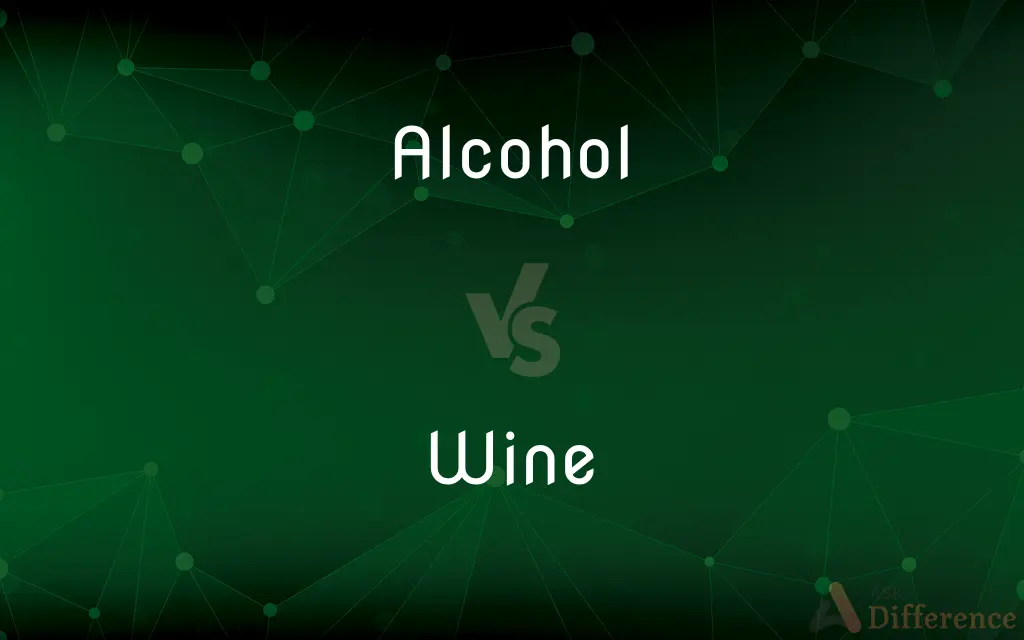Alcohol vs. Wine — What's the Difference?
By Tayyaba Rehman & Urooj Arif — Updated on April 22, 2024
Alcohol is a chemical compound characterized by a hydroxyl group, present in drinks like wine, which is specifically fermented from grapes.

Difference Between Alcohol and Wine
Table of Contents
ADVERTISEMENT
Key Differences
Alcohol refers broadly to any organic compound containing a hydroxyl functional group attached to a carbon atom. It is found in various forms, including ethanol, which is commonly used in beverages. Wine, on the other hand, is a type of alcoholic drink specifically made through the fermentation of grape juice. The sugar in grapes is converted into ethanol and carbon dioxide by yeast, defining wine's basic production process.
The production of alcohol can vary significantly depending on its type and purpose, ranging from simple fermentation processes to complex chemical syntheses. Wine production is comparatively specialized, focusing primarily on the cultivation of grapes, fermentation, and aging processes, which influence its flavor and quality.
Alcohol content in beverages can vary widely; some spirits may contain up to 40-50% alcohol by volume (ABV), while beers typically have around 5-10% ABV. Wine generally contains an ABV of approximately 12-15%, placing it in the middle range of alcohol content among beverages.
Different types of alcohol are used for different purposes beyond consumption, such as in medical applications, cleaning agents, or as a fuel. Wine is primarily consumed as a beverage but also has cultural, culinary, and occasionally medicinal uses, reflecting its importance in various social contexts.
While both terms are associated with social gatherings and cuisine, the cultural significance of wine is particularly pronounced in regions like Europe, where it is deeply integrated into daily life and traditions. Alcohol, in its broader applications, does not carry the same cultural connotation but is essential in various industrial and healthcare settings.
ADVERTISEMENT
Comparison Chart
Definition
A compound with a hydroxyl group.
An alcoholic beverage from grapes.
Types/Forms
Ethanol, methanol, isopropanol.
Red, white, sparkling, rosé.
Typical Use
Beverages, cleaning, fuel.
Primarily consumption.
Alcohol Content
Varies widely (0-95% ABV).
Generally 12-15% ABV.
Cultural Significance
Varied across types.
Strong in many cultures, especially wine-producing regions.
Compare with Definitions
Alcohol
Ethanol.
Ethanol is found in beverages like beer and vodka.
Wine
Red Wine.
Red wine is made from the fermentation of dark-colored grape varieties.
Alcohol
Methanol.
Methanol is used primarily as a solvent and antifreeze.
Wine
White Wine.
White wine is produced by fermenting pulp of grapes without skin contact.
Alcohol
Denatured Alcohol.
Denatured alcohol is ethanol with additives to make it poisonous and undrinkable.
Wine
Sparkling Wine.
Sparkling wine contains significant levels of carbon dioxide, making it fizzy.
Alcohol
Isopropanol.
Isopropanol is often used in disinfectants and cleaning agents.
Wine
Rosé Wine.
Rosé wine is created by juicing red grapes lightly.
Alcohol
Rubbing Alcohol.
Rubbing alcohol is used in household cleaning and as a topical antiseptic.
Wine
Dessert Wine.
Dessert wines are typically sweet and served with the dessert course of a meal.
Alcohol
In chemistry, alcohol is an organic compound that carries at least one hydroxyl functional group (−OH) bound to a saturated carbon atom. The term alcohol originally referred to the primary alcohol ethanol (ethyl alcohol), which is used as a drug and is the main alcohol present in alcoholic drinks.
Wine
Wine is an alcoholic drink typically made from fermented grapes. Yeast consumes the sugar in the grapes and converts it to ethanol, carbon dioxide and heat.
Alcohol
A colourless volatile flammable liquid which is produced by the natural fermentation of sugars and is the intoxicating constituent of wine, beer, spirits, and other drinks, and is also used as an industrial solvent and as fuel
The use of petrol containing alcohol
It is an offence to drive if you have more than 80 mg of alcohol per 100 ml of blood
Wine
An alcoholic drink made from fermented grape juice
He opened a bottle of red wine
The regional foods and wines of France
Alcohol
Any of a series of hydroxyl compounds, the simplest of which are derived from saturated hydrocarbons, have the general formula CnH2n+1OH, and include ethanol and methanol.
Wine
Entertain someone by offering them drinks and a meal
Members of Congress have been lavishly wined and dined by lobbyists for years
Alcohol
A colorless volatile flammable liquid, C2H5OH, synthesized or obtained by fermentation of sugars and starches and widely used, either pure or denatured, as a solvent and in drugs, cleaning solutions, explosives, and intoxicating beverages. Also called ethanol, ethyl alcohol, grain alcohol.
Wine
Dance with rhythmic gyratory movements of the pelvic region
The crowd jumped and wined and churned the field into mud
Alcohol
Intoxicating beverages containing ethanol considered as a group
The national consumption of alcohol.
Wine
A beverage made of the fermented juice of any of various kinds of grapes, usually containing from 10 to 15 percent alcohol by volume.
Alcohol
Any of a class of organic compounds (such as ethanol) containing a hydroxyl functional group (-OH).
Wine
A beverage made of the fermented juice of any of various other fruits or plants.
Alcohol
(colloquial) Ethanol.
Wine
Something that intoxicates or exhilarates.
Alcohol
(uncountable) Beverages containing ethanol, collectively.
Wine
The color of red wine.
Alcohol
(obsolete) Any very fine powder.
Wine
To provide or entertain with wine.
Alcohol
An impalpable powder.
Wine
To drink wine.
Alcohol
The fluid essence or pure spirit obtained by distillation.
Wine
An alcoholic beverage made by fermenting grape juice, with an ABV ranging from 5.5–16%.
Wine is usually stronger than beer.
"Wine improves with age but I improve with wine," she slurred as she slid gracefully beneath the table.
Alcohol
Pure spirit of wine; pure or highly rectified spirit (called also ethyl alcohol or ethanol, CH3.CH2.OH); the spirituous or intoxicating element of fermented or distilled liquors, or more loosely a liquid containing it in considerable quantity. It is extracted by simple distillation from various vegetable juices and infusions of a saccharine nature, which have undergone vinous fermentation.
Wine
An alcoholic beverage made by fermenting other substances, producing a similar ABV.
...dandelion wine, rice wine, plum wine...
Alcohol
A class of compounds analogous to vinic alcohol in constitution. Chemically speaking, they are hydroxides of certain organic radicals; as, the radical ethyl forms common or ethyl alcohol (C2H5.OH); methyl forms methyl alcohol (CH3.OH) or wood spirit; amyl forms amyl alcohol (C5H11.OH) or fusel oil, etc.
Wine
(countable) A serving of wine.
I'd like three beers and two wines, please. My friend will have the same.
Alcohol
A liquor or brew containing alcohol as the active agent;
Alcohol (or drink) ruined him
Wine
(uncountable) The color of red wine, a deep reddish purple.
Alcohol
Any of a series of volatile hydroxyl compounds that are made from hydrocarbons by distillation
Wine
Wind.
Wine
(transitive) To entertain with wine.
Wine
(intransitive) To drink wine.
Wine
The expressed juice of grapes, esp. when fermented; a beverage or liquor prepared from grapes by squeezing out their juice, and (usually) allowing it to ferment.
Wine is a mocker, strong drink is raging, and whosoever is deceived thereby is not wise.
Bacchus, that first from out the purple grapeCrushed the sweet poison of misused wine.
Wine
A liquor or beverage prepared from the juice of any fruit or plant by a process similar to that for grape wine; as, currant wine; gooseberry wine; palm wine.
Wine
The effect of drinking wine in excess; intoxication.
Noah awoke from his wine.
Wine
Fermented juice (of grapes especially)
Wine
A red as dark as red wine
Wine
Drink wine
Wine
Treat to wine;
Our relatives in Italy wined and dined us for a week
Common Curiosities
What is the typical alcohol content of wine?
Wine typically has an alcohol content of about 12-15% ABV.
Is all alcohol drinkable?
Not all alcohol is drinkable; some forms, like methanol and isopropanol, are toxic and used industrially.
What is the primary chemical structure of alcohol?
Alcohol is characterized by having one or more hydroxyl groups attached to a carbon atom.
Are there health benefits to drinking wine?
Moderate wine consumption has been linked to various health benefits, including heart health, due to antioxidants like resveratrol.
What is the global significance of wine compared to other alcohols?
Wine holds significant cultural importance, especially in regions known for wine production, unlike some other forms of alcohol which are more universally used but less culturally specific.
How is wine produced?
Wine is produced by fermenting crushed grapes using yeast, which converts the sugars in grapes to alcohol and carbon dioxide.
What is fortified wine?
Fortified wine is a wine to which a distilled spirit, usually brandy, is added.
Can alcohol be consumed in non-beverage forms?
Yes, some forms of alcohol like rubbing alcohol are used for cleaning and medicinal purposes but are not safe for consumption.
What are the main types of wine?
The main types of wine include red, white, sparkling, and rosé.
What is the difference between vintage and non-vintage wine?
Vintage wine is made from grapes harvested in a specific year, while non-vintage wine blends multiple years' harvests to maintain a consistent flavor profile.
What role does yeast play in wine production?
Yeast is crucial in wine production as it ferments the sugars present in grapes, producing alcohol and carbon dioxide.
What are tannins, and how are they related to wine?
Tannins are compounds present in wine that contribute to its flavor profile and astringency, particularly in red wine.
What is organic wine?
Organic wine is produced from grapes grown without the use of chemical pesticides or fertilizers.
Can wine be used for cooking?
Yes, wine is widely used in cooking to enhance the flavor of dishes.
How does the alcohol in wine compare to that in beer?
Wine generally has a higher alcohol content than beer, which usually contains about 5-10% ABV.
Share Your Discovery

Previous Comparison
Earthquake vs. Volcano
Next Comparison
Ess vs. EstAuthor Spotlight
Written by
Tayyaba RehmanTayyaba Rehman is a distinguished writer, currently serving as a primary contributor to askdifference.com. As a researcher in semantics and etymology, Tayyaba's passion for the complexity of languages and their distinctions has found a perfect home on the platform. Tayyaba delves into the intricacies of language, distinguishing between commonly confused words and phrases, thereby providing clarity for readers worldwide.
Co-written by
Urooj ArifUrooj is a skilled content writer at Ask Difference, known for her exceptional ability to simplify complex topics into engaging and informative content. With a passion for research and a flair for clear, concise writing, she consistently delivers articles that resonate with our diverse audience.














































